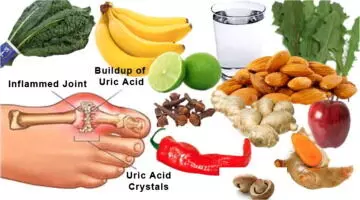Understanding Uric Acid: symptoms, causes, and remedies

Dr. Pranjal Konwar
Uric acid is a natural waste product formed when the body breaks down purines—substances found in various foods and also produced by the body. Normally, uric acid dissolves in the blood, passes through the kidneys, and is excreted in urine. However, when the body produces too much uric acid or the kidneys don’t eliminate enough of it, uric acid can build up in the bloodstream, leading to a condition known as hyperuricemia. This condition, if left unchecked, can result in gout—a form of arthritis characterized by sudden, severe attacks of pain, redness, and swelling in the joints. The most common symptom of high uric acid is joint pain, especially in the big toe. People often wake up in the middle of the night with intense discomfort in the affected area, which becomes red, swollen, and extremely sensitive to touch. Over time, this can affect other joints such as the ankles, knees, wrists, and elbows. Stiffness in the joints and restricted movement can develop if uric acid levels remain elevated over long periods. In some cases, visible lumps called tophi may form under the skin, particularly around the joints and ears, indicating chronic gout. Aside from joint symptoms, high uric acid can also lead to the formation of kidney stones, which manifest as severe pain in the back or abdomen, nausea, and blood in the urine. Dietary habits, genetics, and lifestyle factors play a significant role in determining uric acid levels. Consuming foods rich in purines such as red meat, organ meats, shellfish, and certain types of fish can increase uric acid production. Sugary drinks, alcohol—especially beer—and foods high in fructose can also contribute to elevated levels. Being overweight or obese, having high blood pressure, diabetes, or kidney disease are additional risk factors that can exacerbate the condition. Managing uric acid at home is possible through a combination of dietary changes and natural remedies. Staying well hydrated is one of the most effective ways to help the kidneys flush out excess uric acid. Drinking plenty of water throughout the day assists in diluting the acid and promoting its excretion through urine. Including lemon water in the daily routine can also help, as lemon juice alkalizes the body and may prevent uric acid crystal formation. Cherries, whether eaten fresh or in juice form, are believed to reduce uric acid levels and ease gout symptoms. They contain antioxidants and compounds that help reduce inflammation and lower uric acid. Likewise, incorporating foods rich in vitamin C—such as oranges, guavas, and bell peppers—can support the body’s ability to eliminate uric acid. Consuming fiber-rich foods, including whole grains, vegetables, and fruits, not only aids digestion but also helps reduce uric acid absorption in the bloodstream. Avoiding purine-rich foods is crucial. Reducing the intake of red meats, processed foods, and alcohol can have a significant impact. Dairy products, particularly low-fat ones, may be beneficial in managing uric acid levels. Regular physical activity, maintaining a healthy weight, and managing stress are also vital aspects of overall wellness that influence uric acid metabolism. While home remedies can be effective in mild cases, persistent or severe symptoms warrant medical attention. Doctors may prescribe medications to reduce uric acid production or improve its elimination. It's important to get regular blood tests to monitor levels and follow a comprehensive health plan. Uric acid is a manageable condition with awareness, lifestyle adjustments, and proper care. With a balanced diet, adequate hydration, and timely intervention, it is possible to maintain healthy levels and prevent the painful complications associated with high uric acid.


